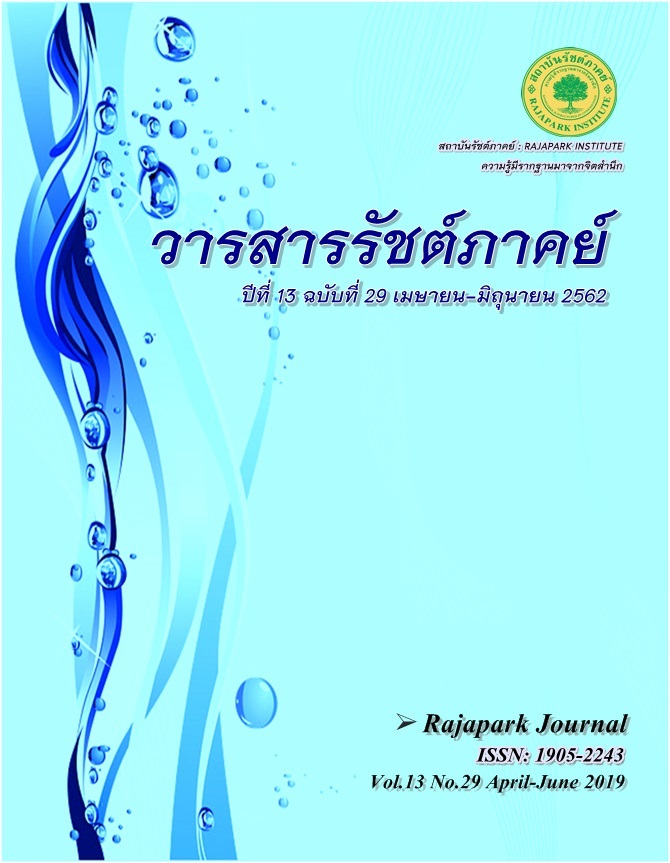Suitability Between Individuals and the Environment
Main Article Content
Abstract
This article reviews literatures on person and environment fit and also suggestions for future research. The concept of person and environment fit is defined as the degree of congruence or match between personal and situational variables in producing significant outcomes. There are many conceptualization dimensions. First, P-E fit can be conceptualized as supplementary fit and complementary fit, where complementary fit comprises of two more aspects as needs-supplies fit (N-S fit) and demands- abilities fit (D-A fit). Second, P-E fit can be conceptualized as perceived (subjective) fit versus actual (objective) fit. Afterward, the two most essentially studied fit constructs in P-E fit, which are P-o fit and P-J fit are reviewed. And finally, future research is suggested for further study.
Article Details

This work is licensed under a Creative Commons Attribution-NonCommercial-NoDerivatives 4.0 International License.
Views and opinions appearing in the Journal it is the responsibility of the author of the article, and does not constitute the view and responsibility of the editorial team.
References
Amy, L., Kristof-Brown, A. L., Zimmerman, R. D., & Johnson, E. C. (2005). “Consequences of individuals’ fit at work: a meta-analysis of person-job, person-organization, person-group, and person-supervisor fit,” Journal of Personnel Psychology, 58, 281-342.
Bowen, D. E., Ledford, G. E., & Nathan, B. R. (1991). Hiring for the organization, not the job. Academy of Management Executive, 5(4), 35-51.
Boxx, W. R., Odom, R. Y., & Dunn, M. G. (1991). Organizational values and value congruency and their impact on satisfaction, commitment, and cohesion. Public Personnel Management, 20, 195-205.
Cable, D. M., & Judge, T. A. (1996). Person-organization fit, job choice decisions, and organizational entry. Organizational Behavior and Human Decision Processes, 67, 294-311.
Cable, D. M., & Parson, C. K. (2001). Socialization tactics and person-organization fit. Personnel Psychology, 54, 1-23.
Chatman, J. A. (1991). Matching people and organizations: Selection and socialization in public accounting firms. Administrative Science Quarterly, 36, 459-484.
Dawis, R. V., & Lofquist, L. H. (1984). A Psychological Theory of Work Adjustment: An Individual-Differences Model and Its Applications [Electronic version]. Minneapolis: University of Minnesota Press. Retrieved March 10, 2012, from https://www.psych.umn.edu/psylabs/vpr/pdf_files/Psychological%20Theory%20of%20Work%20Adjustment.pdf
Deci, E. L., & Ryan, R. M. (2000). The "what" and "why" of goal pursuits: Human needs and the self-determination of behavior [Electronic version]. Psychological Inquiry, 11, 227-268. Retrieved October 2, 2011, from http://aipa.groups.psychology.org.au/Assets/Files/The-what-and-why-of-goal-pursuits.pdf
Edwards, J. R. (1991). Person-job fit: A conceptual integration, literature review, and methodological critique [Electronic version]. In Cooper, C. L., & Robertson, I. T. (Eds.), International review of industrial and organizational psychology, 6, 283-357, Oxford, England: John Wiley & Sons. Retrieved March 29, 2012, from http://public.kenanflagler.unc.edu/faculty/edwardsj/Edwards1991.pdf
Fisher, C. D. (2010). Happiness at work [Electronic version]. International Journal of Management Reviews, 12(4), 384-412. Retrieved January 15, 2012, from http://epublications.bond.edu.au/business_pubs/304
Haggins, C. A. (2000). The effect of applicant influence tactics on recruiter perceptions of fit. Unpublished dissertation, University of Iowa.
Kristof, A. L. (1996). Person-Organization Fit: An Integrative Review of its Conceptualizations, Measurement, and Implication [Electronic version]. Personnel Psychology, 49(1), 1-49. Retrieved March 31, 2012, from http://www.tamu.edu/faculty/bergman/kristoff1996.pdf
Lait, J., & Wallace, J. E. (2002). Stress at work: A study of organizational-professional conflict and unmet expectations [Electronic version]. Relations Industrielles, summer 2002, 57(3), 463. Retrieved December 9, 2011, from http://search.proquest.com/docview/224275494/fulltextPDF/137226D27F2BC76927/1?accountid=44787
Lauver, K. J., & Kristof-Brown, A. (2001). Distinguishing between employees’ perceptions of person-job and person-organization fit. Journal of Vocational Behavior, 59, 454-470.
Muchinsky, P. M., & Monohan, C. J. (1987). What is person-environment congruence? Supplementary versus complementary models of fit. Journal of Vocational Behavior, 31, 268-277.
Pryce-Jones, J. (2010). Happiness at Work: Maximizing your Psychological Capital for success. Wiley-Blackwell, UK.
Schneider, B. (1987). The people make the place. Personnel Psychology, 40, 437-454.
Tranberg, M., Slane, S., & Ekeberg, S. E. (1993). The Relation between Interest Congruence and Satisfaction: A Meta-analysis. Journal of Vocational Behavior, 42(3), 253-264.
Warr, P. (2007). Work, Happiness, and Unhappiness. New Jersey: Lawrence Erlbaum Associates.


